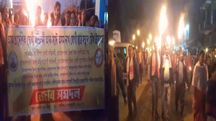Assam floods submerge 61 camps in Kaziranga, Agoratoli Range most affected
Heavy rainfall in Assam has led to severe flooding in Kaziranga National Park, submerging numerous forest camps and impacting both wildlife and human populations. State authorities are implementing measures to mitigate the disaster's effects.
 Photo credit: ANI
Photo credit: ANIHeavy rainfall in Assam has led to flooding in the Kaziranga National Park and Tiger Reserve (KNPTR), with 61 out of 233 camps submerged. Field Director Sonali Ghosh reported that the Agoratoli range is the most affected, with 22 forest camps underwater.
Park authorities have implemented safety measures for wildlife protection, including speed sensor cameras on National Highway 37 and increased forest guard deployment. These efforts aim to control vehicle speeds and minimise animal casualties during their migration to higher ground.
The flood situation in Assam has worsened, affecting over 2.62 lakh people across 12 districts. Union Minister Sarbananda Sonowal assessed the conditions in his constituency, Dibrugarh, directing officials to take immediate action to mitigate the impact.
ALSO WATCH: Assam government implements traffic arrangements in Kaziranga National Park amid floods
The death toll has risen to 34, with two children drowning in the Dhemaji district on June 30. The Assam State Disaster Management Authority (ASDMA) continues to monitor the situation as flood waters submerge new areas.
Affected districts include Kamrup, Karimganj, Tinsukia, Golaghat, Dhemaji, Majuli, Cachar, Lakhimpur, Dibrugarh, Sivasagar, Kokrajhar, and Jorhat. As the second wave of flooding persists, state authorities are working to provide relief and support to those impacted by the natural disaster.
The flooding of Kaziranga National Park, a UNESCO World Heritage site and home to two-thirds of the world's one-horned rhinoceros population, underlines the environmental challenges posed by Assam's annual monsoon floods.
Copyright©2026 Living Media India Limited. For reprint rights: Syndications Today









